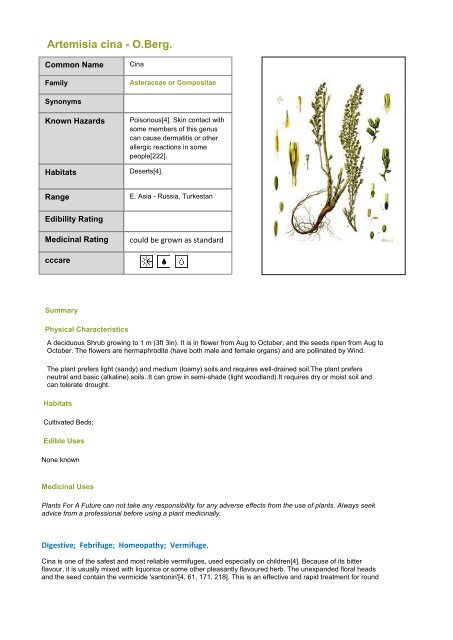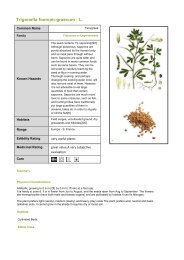Create successful ePaper yourself
Turn your PDF publications into a flip-book with our unique Google optimized e-Paper software.
<strong>Artemisia</strong> <strong>cina</strong> - O.<strong>Berg</strong>.<br />
Common Name<br />
Family<br />
Synonyms<br />
Known Hazards<br />
Habitats<br />
Range<br />
Edibility Rating<br />
Medi<strong>cina</strong>l Rating<br />
cccare<br />
Summary<br />
Physical Characteristics<br />
CareCareCare<br />
A deciduous Shrub growing to 1 m (3ft 3in). It is in flower from Aug to October, and the seeds ripen from Aug to<br />
October. The flowers are hermaphrodite (have both male and female organs) and are pollinated by Wind.<br />
The plant prefers light (sandy) and medium (loamy) soils and requires well-drained soil.The plant prefers<br />
neutral and basic (alkaline) soils..It can grow in semi-shade (light woodland).It requires dry or moist soil and<br />
can tolerate drought.<br />
Habitats<br />
Cultivated Beds;<br />
Edible Uses<br />
None known<br />
Medi<strong>cina</strong>l Uses<br />
Cina<br />
Asteraceae or Compositae<br />
Poisonous[4]. Skin contact with<br />
some members of this genus<br />
can cause dermatitis or other<br />
allergic reactions in some<br />
people[222].<br />
Deserts[4].<br />
E. Asia - Russia, Turkestan<br />
could be grown as standard<br />
crops<br />
Plants For A Future can not take any responsibility for any adverse effects from the use of plants. Always seek<br />
advice from a professional before using a plant medi<strong>cina</strong>lly.<br />
Digestive; Febrifuge; Homeopathy; Vermifuge.<br />
Cina is one of the safest and most reliable vermifuges, used especially on children[4]. Because of its bitter<br />
flavour, it is usually mixed with liquorice or some other pleasantly flavoured herb. The unexpanded floral heads<br />
and the seed contain the vermicide 'santonin'[4, 61, 171, 218]. This is an effective and rapid treatment for round
worms, it is also effective for thread worms, though it does not affect tapeworms[4]. The plant is also used as a<br />
febrifuge and as an aid to the digestion[232]. Caution is advised in the use of this plant since it is poisonous in<br />
large doses[4]. This plant should not be used by pregnant women[254]. The dried flowers are used to make a<br />
homeopathic remedy[232]. This is particularly useful for complaints of the nervous system and the digestive<br />
tract[232]. A homeopathic remedy made from the plant is used to rid children of worms[238].<br />
Other Uses<br />
None known<br />
Cultivation details<br />
We have very little information on this species and do not know if it will be hardy in Britain. Although this plant<br />
has woody stems, these tend to die back each winter giving the plant a herbaceous habit. It is cultivated as a<br />
medi<strong>cina</strong>l plant in Russia and N. America[61, 171, 266]. The following notes are based on the general needs of<br />
the genus. Easily grown in a well-drained circumneutral or slightly alkaline loamy soil, preferring a sunny<br />
position[1, 200]. Established plants are very drought tolerant[200]. Plants are longer lived, more hardy and more<br />
aromatic when they are grown in a poor dry soil[245]. Plants in this genus are notably resistant to honey<br />
fungus[200]. Members of this genus are rarely if ever troubled by browsing deer[233].<br />
Propagation<br />
Seed - surface sow from late winter to early summer in a greenhouse[200]. When large enough to handle, prick<br />
the seedlings out into individual pots and plant them out in the summer. Cuttings of half-ripe wood, July/August in<br />
a frame. Division in spring or autumn.



